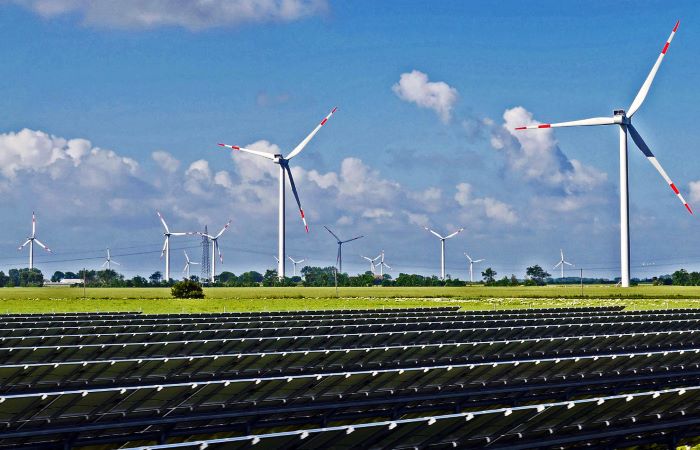Based on various tenders allowed by the Centre and states, a new IEEFA report estimates India’s total wind-solar hybrid capacity will reach 11.7 GW by 2023. The report said the wind-solar hybrid capacity will rise at a compound annual growth rate of 223% from 2020-2023.
IEEFA said the hybrid cavity, which is at 148 megawatts (MW) at present, would increase almost 80 times in the next three years thanks to incentives by the Centre and state in the next three years. The report pointed out that SECI tenders for wind-solar hybrid projects without storage have attracted low tariffs of ₹2.67 per kWh, which were comparable to plain solar tariffs. The government also plans to hold renewable energy auctions for round-the-clock and hybrid projects instead of plain solar or wind tenders.
Minister: India may set up 20 GW more domestic manufacturing capacity
India;’s Power minister said his ministry has received expressions of intent to set up 20 GW more domestic solar module and cell manufacturing capacity adding that the interest in establishing new units was independent of plans to subsidize borrowing rates on loans through an ‘interest subvention’ scheme planned by the Ministry of New & Renewable Energy (MNRE).
India’s current annual installed and functional manufacturing capacity of solar modules is around 10 GW per year while that of solar cells is only around 2.5-3 GW per year, the minister said. It currently relies on cheaper imports, mainly from China, to meet the bulk of its demand for solar cells and modules.
IEA: Solar to be new energy king next decade, RE to overtake coal by 2025
According to the latest annual World Energy Outlook by IEA, India will lead the demand for energy globally over the next 10 years. Energy demand was projected to grow by 12% between 2019 and 2030 before the novel coronavirus disease (COVID-19) pandemic struck, the WEO-2020, stated.
In the next 10 years, solar power is expected to lead the surge in renewable power supply, the International Energy Agency report stated. Renewables are expected to overtake coal as the primary means of producing electricity by 2025, IEA World Energy Outlook stated.
IEA director Fait Birol said solar will become the new king of the world power market. Consider this, the combined share of solar photovoltaic (PV) and wind in global generation will rise to almost 30% in 2030 from 8% in 2019, the report said, with solar PV capacity growing by an average 12% annually.
State data says share of renewables in India’s power mix increases to 26% from 23%
According to the Central Electricity Authority, the share of RE in India’s power mix has increased from 23% to 26% in April-August period this fiscal, ET reported. Green energy’s share increased at a time when the power sector witnessed sluggish demand due to the COVID-19 pandemic.
(CEA) chairman Prakash Mhaske said India will reach the target of carbon emission intensity reduction by 30-33% before the pledged year of 2030.
IEA says COVID-19 to delay world energy demand recovery to 2025, Fitch revises India forecast
The COVID-19 economic slowdown may delay full recovery of global power demand to 2025, said International Energy Agency (IEA). In its annual World Energy Outlook, the agency said in the main scenario, a vaccine and medicine could mean the global economy rebounds in 2021 and energy demand recovers by 2023, but under a “delayed recovery scenario”, the timeline is likely to stretch to 2025.
According to the latest annual World Energy Outlook by IEA, India will lead the demand for energy globally over the next 10 years. Energy demand was projected to grow by 12% between 2019 and 2030 before the novel coronavirus disease (COVID-19) pandemic struck, the WEO-2020, stated.
Meanwhile, according to credit rating agency Fitch, India’s power consumption may decline by 6.6% and power generation by 6.8%, while power capacity will grow by only 2.7% this year. The rating agency said its previous forecast of slight recovery in the second half of 2020 post COVID-19 won’t take place now because of medium-term pressures on the sector from multiple fronts.
About The Author
You may also like
World, led by China, added 50% more RE capacity in 2023 than in 2022: IEA report
Renewables, not coal, the energy of choice for investors in India for second year in a row: Report
Hope to raise $50 million for solar in next few months; focus on Africa: ISA chief
About 6 lakh new technicians needed globally for wind energy sector by 2027: Report
12% of global growth in solar generation in first half of 2023 came from India: Report


